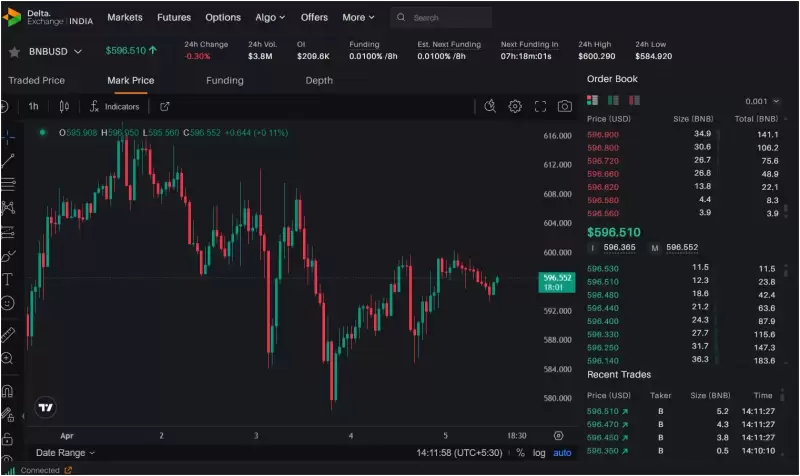 |
|
 |
|
 |
|
 |
|
 |
|
 |
|
 |
|
 |
|
 |
|
 |
|
 |
|
 |
|
 |
|
 |
|
 |
|
Cryptocurrency News Articles
Bitcoin's Safe Haven Potential Examined as Gold and Government Bonds Fail the Test
Apr 12, 2025 at 09:01 pm
The idea of "safe haven" assets—traditionally marked by gold and government bonds—amid market turmoil, is being tested like never before.

The concept of "safe haven" assets, traditionally associated with gold and government bonds amid market turmoil, is being examined more closely than ever before.
For decades, portfolio construction and risk management were simple: 60% equities, 40% bonds and when markets panicked, capital typically flowed into gold and government bonds. These assets were slow, steady, and predictable, making them an ideal safe haven for investors seeking protection against volatility. But in today’s world of 24/7 markets, geopolitical instability, and rising distrust in sovereign systems, have turned that logic on its head, asking the question: does the definition of a safe haven need a refresh?
Enter the new kid in the block: bitcoin.
It is highly volatile, widely misunderstood, and often dismissed as a speculative asset by many corners of Wall Street and Main Street. Yet, it has staged an extraordinary run since the COVID-19 market lows.
It’s up over 1,000% since the COVID-19 market crash in March 2020. During that same period, long-duration bonds—measured via iShares 20+ Year Treasury Bond ETF (TLT)—are down 50% from their 2020 highs. Even gold, the true and tried safe haven asset—up 90% over five years—looks less impressive when adjusted for monetary debasement, which saw, in 2020 alone, over 40% of the total USD money supply being printed.
Still, bitcoin’s safe haven credential remains contested by investors.
In several recent risk-off events, it acted less like a hedge and more like a high-beta risk asset against the Invesco QQQ Trust, Series 1 ETF.
The first three examples show bitcoin as a kind of leveraged tech trade. But the most recent tariff shock broke the pattern — bitcoin dropped less than the Nasdaq, showing relative strength in an otherwise weak macro environment spurred by President Trump’s tariffs.
While these data points may not make a trend, this evolving behavior highlights a broader phenomenon: the global financial backdrop has changed.
“Non-sovereign stores of value, like bitcoin, should do well," said NYDIG Research in a note. "Politically neutral assets are exempt from the global machinations at play right now.”
Bitcoin is volatile, yes, but it is also globally liquid, decentralized, censorship-resistant, and immune to tariffs or central bank policy. In an era of geopolitical tension and financial repression, those attributes start to make the asset look more enduring than other safe havens.
Meanwhile, traditional safe havens aren’t looking so safe. Gold’s gains look less impressive when weighed against the scale of monetary expansion. Long-duration bonds aren't faring much better either as the 30-year treasury yield approaches 5%, making them painful for duration-heavy portfolios.
Since the sell-off began last Thursday, the Nasdaq has dropped nearly 10%, bitcoin is down 6%, TLT has fallen over 4%, and gold has slipped more than 3%. Meanwhile, the DXY index — which tracks the U.S. dollar against a basket of foreign currencies — remains relatively flat, while the all-important U.S. 10-year Treasury yield has surged nearly 8%.
On a risk-adjusted basis, bitcoin is holding its ground—performing no worse than traditional safe-haven assets like gold or TLT.
Looking at these four major crisis events, a pattern emerges: : each sell-off in bitcoin has marked a significant long-term bottom. During the COVID crash, BTC dropped to ~$4,000 — a level never seen again. In the March 2023 banking crisis, it briefly fell below $20,000 before resuming its climb. The August 2024 yen carry trade unwinding brought it down to $49,000 — again, a level that hasn’t returned. If history is any guide, wherever this current low takes us, it may well establish the next long-term floor.
So, is Bitcoin a safe haven?
If the old framing — low volatility and downside protection during a panic — still holds, then BTC falls short.
But in a financial world dominated by sovereign risk, inflation, and constant policy uncertainty, bitcoin starts to look more like an asset that investors might need to consider for durability, neutrality and liquidity.
In this evolving landscape, maybe bitcoin isn’t failing the safe haven test. Maybe the old playbook of what safe haven is, needs to change.
Disclaimer:info@kdj.com
The information provided is not trading advice. kdj.com does not assume any responsibility for any investments made based on the information provided in this article. Cryptocurrencies are highly volatile and it is highly recommended that you invest with caution after thorough research!
If you believe that the content used on this website infringes your copyright, please contact us immediately (info@kdj.com) and we will delete it promptly.
-

-

- Virtual Magnet Motor Innovator Volektra Raises New Funding to Commercialize Its Technology
- Apr 13, 2025 at 05:10 am
- Electric drivetrain innovator Volektra has secured a new funding round to commercialize its proprietary Virtual Magnet motor technology–an industry-first breakthrough that eliminates rare earth magnets
-

-

-

-

-

-

-
![Bitcoin [BTC] has followed that pattern, with a 3.22% rally during this period. This seemed to indicate that market confidence is growing. Bitcoin [BTC] has followed that pattern, with a 3.22% rally during this period. This seemed to indicate that market confidence is growing.](/assets/pc/images/moren/280_160.png)
- Bitcoin [BTC] has followed that pattern, with a 3.22% rally during this period. This seemed to indicate that market confidence is growing.
- Apr 13, 2025 at 04:50 am
- As the cryptocurrency market gains ground, Bitcoin [BTC] has followed that pattern, with a 3.22% rally during this period. This seemed to indicate that market confidence is growing.





























































![Bitcoin [BTC] has followed that pattern, with a 3.22% rally during this period. This seemed to indicate that market confidence is growing. Bitcoin [BTC] has followed that pattern, with a 3.22% rally during this period. This seemed to indicate that market confidence is growing.](/uploads/2025/04/13/cryptocurrencies-news/articles/bitcoin-btc-pattern-rally-period-market-confidence-growing/middle_800_480.webp)